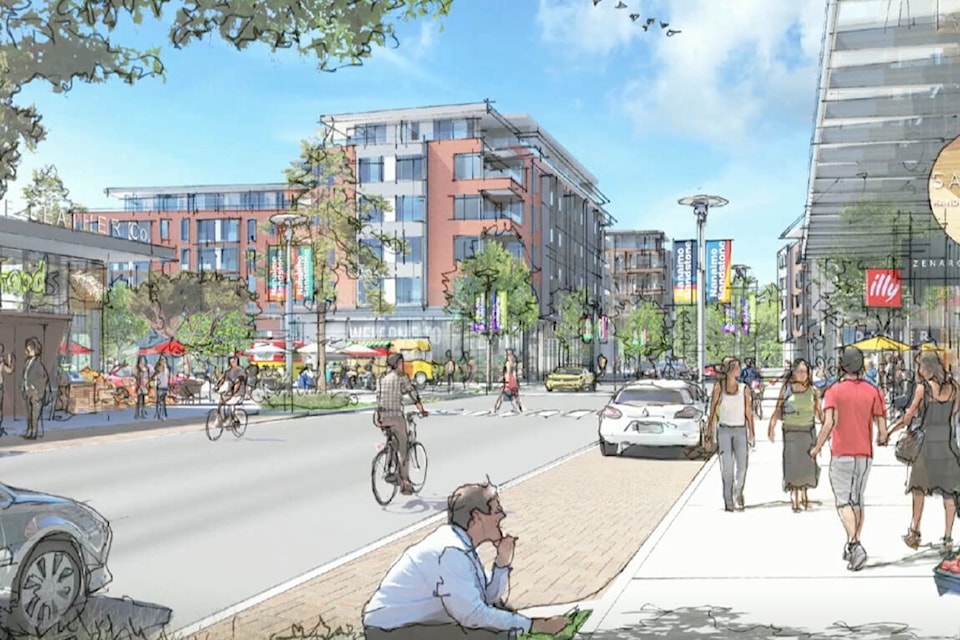BY GREG SAKAKI
Re-zoning of the huge Sandstone development in Nanaimo’s Cedar and Chase River areas is now underway.
City council, at a meeting Monday, Oct. 16, passed first and second reading of a zoning amendment bylaw that would allow for development of Sandstone lands along Cedar Road, Fielding Road and Rajeena Way.
Council approved Sandstone’s master plan approximately a year and a half ago and work has continued since then, with the applicant, numerous city departments and outside agencies involved, to advance to the re-zoning stage.
“This re-zoning application is the most significant application that I’ve been involved in in the City of Nanaimo,” said Jeremy Holm, the city’s director of planning and development, speaking to councillors at this week’s meeting. “Since the adoption of the Sandstone master plan, significant effort’s gone into work in getting this in front of you tonight … It impacted many areas in the city.”
The Sandstone plan divides the land into six development areas. The two southeastern areas are already zoned industrial and are not part of the re-zoning application. The applicant Seacliff Properties is seeking to re-zone 1100 Cedar Rd. and 1750 Rajeena Way to steep-slope residential, 1605 Fielding Rd. to light industrial, and 1505 Fielding Rd. to a comparatively higher-density comprehensive development zone that will be the site of the neighbourhood centre with commercial, residential and recreational uses.
A city staff report noted that Sandstone’s development will be phased over more than two decades, but the ultimate build-out is anticipated to include 800 single-family homes, 500 townhouses, 900 condos or apartments, 178,000 square feet of commercial space, and 1.8 million square feet of industrial floor area.
“With these large-scale, long-term projects, setting in stone a phasing plan is a very difficult thing to do because it’s critically important to stay nimble, to be able to adapt to changing market conditions over time,” said Georgia Desjardins, director of development with Seacliff Properties. “With that said, I think Seacliff is keenly aware of the strong demand and strong need for both housing and industrial.”
She said at this time, the developer envisions a concurrent approach with residential development likely to begin in Chase River at the same time as industrial development in the already-zoned industrial land closest to Duke Point. She noted that residential development will trigger “significant off-site infrastructure upgrades” to the transportation network in Chase River.
Lainya Rowett, the city’s manager of current planning, told council that the location of the Sandstone lands along highway corridors limits potential transportation access points and route redundancies. Further detail was provided in the staff report and a traffic impact assessment.
“As Sandstone develops, it is expected to be a significant contributor to the growth in traffic in the area,” the report noted. “It is forecast that Sandstone would comprise the majority of the increase in traffic on Extension Road, Cedar Road and the Island Highway within the study area.”
Mitigation measures contemplated include the long-discussed Cranberry connector, a Maki Road-Fielding Road connector, and upgrades to Extension Road and Cedar Road.
The staff report concluded that the existing transportation network, with all mitigation measures in place, can support the planned growth in the area, “though there will be a degradation of the level of service.”
The traffic assessment noted that without the mitigation measures, the Trans-Canada Highway between Tenth Street and Cranberry Avenue could see current traffic levels more than double to 40-50,000 vehicle trips per day over the next 20 year, and Cedar Road between the highway and Fielding Road could see traffic volumes nearly triple to 25-30,000 vehicles per day. As a comparison, Bowen Road at Beban Park currently sees 25,000 vehicle trips per day and Aulds Road near Metral Drive sees 27,000 per day.
Not all the necessary traffic mitigation measures are part of the developer’s proposal, so some of the money needed for road construction and re-construction will need to come from development cost charges and local or provincial government funding. Planning-level estimates suggest the Maki-Fielding connector could cost $30 million, the Cranberry connector $20 million, Cedar Road upgrades $15-20 million and Extension Road upgrades $5-15 million.
READ ALSO:
The developer is proposing a package of community amenity contributions including transferring one hectare in Cedar to the city, two hectares in Chase River to Nanaimo Ladysmith Public Schools, and 51.4ha to the Snuneymuxw First Nation, and also plans other park dedications and a multi-use trail in Cedar.
City staff support the re-zoning application. Rowett said the technical review of the application included a number of technical studies to help the city understand the potential impacts of the development, not only transportation but also servicing and utilities as well as environmental considerations. She expressed the view that Sandstone’s re-zoning application ultimately reinforces goals and objectives of the Nanaimo Reimagined city plan and the regional growth strategy guiding development within urban containment boundaries.
“The proposed land use will support development from a regional growth perspective and address the diversity and supply some of the region’s housing and industrial land demands,” the staff report noted.
City councillors did not debate the re-zoning application at second reading and voted 7-2 in favour of advancing the proposal to the public hearing stage. Councillors Tyler Brown and Ben Geselbracht were opposed.
READ ALSO:
READ ALSO:



